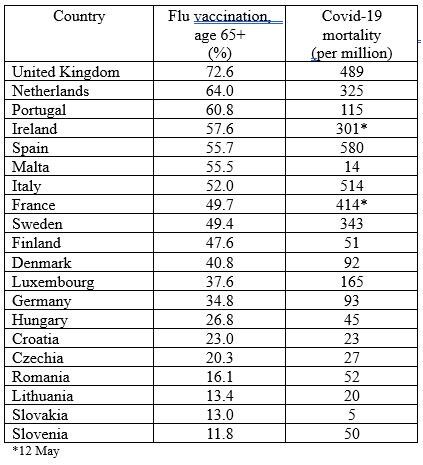However, a factor that hasn't been considered is the flu vaccine, which is widely administered to the elderly. Some correlation with Covid-19 mortality, although not necessarily causal, is readily apparent. The medical establishment tends to cast any critic of vaccination as an extremist, but we are not 'anti-vaxxers'. We present our case tentatively, and leave it to readers to decide whether this is a reasonable line of enquiry.
Influenza is a contagion that strikes every winter, with symptoms of headache, fever, chill, sore throat, muscle aches, fatigue, nasal congestion and cough. Severe cases lead to pneumonia, a common cause of death in the elderly. The first vaccine against influenza was produced by Ernest Williams Goodpasture at Vanderbilt University in 1931, and vaccination became widely available after the Second World War.
Flu vaccination had its first major contest with the Asian flu pandemic of 1957-1958, which killed two million worldwide. Although the vaccine failed to protect, the high mortality was attributed to insufficient coverage: the pharmaceutical industry thus turned defeat into victory. In 1960 routine flu vaccination was recommended by the US Centers for Disease Control. Since then, pandemics have been regularly exploited by the pro-vaccine lobby, which has a hold on the medical establishment, to demand wider use of the flu shot.
A challenge for flu vaccine producers is the volatility of the virus, which mutates rapidly. A new vaccine is needed every autumn, based on guessing which strains will emerge. In practice, the preventive performance is poor. A review in 2014 by the Cochrane Collaboration, an international body for evidence-based medicine, revealed that the vaccines reduced incidence of influenza by a mere 6%. Tom Jefferson, one of the authors, has described evidence for flu vaccination as 'rubbish'.
Jefferson was also involved in a controversy over Tamiflu. This drug was stockpiled by governments, after a Cochrane review showing that it reduced complications of influenza. When it transpired that most of the studies were sponsored by the manufacturer, Jefferson sought the original data but Roche refused. A subsequent Cochrane review did not replicate the impressive findings, and much public money was wasted on a highly profitable but ineffectual treatment. Needing to be seen to do something, governments are not helped by guidance that should be scientifically objective but is prone to commercial influence.
With heavy marketing and medical hubris, uptake of the flu jab increased, particularly in the vulnerable elderly population. In 2009, health ministers across the EU agreed to a target of vaccinating 75% of older people against influenza. However, ten years later, no country had achieved this, the average being 44.3%.
Recent developments in flu vaccines may be relevant. In October 2019 the UK was the first country in Europe to introduce Flucelvax Tetra, which was touted as 36% more effective. Until then, flu vaccines were always produced in hens' eggs, which are a good incubator for the virus. For the UK alone, around 50 million eggs were needed for the annual vaccine supply. The new vaccine, however, is created in vats of cells from dogs' kidneys, which are more similar to ours than those of chickens.
Covid-19 is a coronavirus, thus not covered by flu vaccines. It has been suggested, though, that the flu jab may lower immunity to other upper respiratory tract infections. In the BMJ, paediatrician Alan Cunningham wrote:
Such an observation may seem counter-intuitive, but it is possible that influenza vaccines alter our immune systems non-specifically to increase susceptibility to other infections; this has been observed with DTP and other vaccines."Compare flu vaccine frequency in older people with Covid-19 mortality, using figures from Vaccines Today EU and Worldometer (13 May 2020):
Among countries omitted in the EU data was Belgium, which has the highest Covid-19 mortality rate in the world, at 763 per million. While specific data for older people were not available on the official Belgian statistics website, flu vaccination coverage of the overall population is relatively high. Overall, a clear difference is apparent between east and west Europe, both in vaccine uptake and Covid-19 deaths. This may be merely coincidental, but it warrants investigation.
Outside Europe, the pattern does not hold so clearly, but there may be good reasons for the exceptions. Globally the highest uptake of the flu vaccine by seniors in 2018-2019 was in South Korea, at 83%. Third (after the UK) was the USA with 68%, and fourth was New Zealand with 67%. Neither New Zealand nor South Korea fit the hypothesis, these countries having a mortality of merely 4 and 5 per million respectively. South Korea, Hong Kong, Taiwan and South Korea managed Covid-19 extremely well, despite their large populations and proximity to the source in China. Their efficient use of tracking and tracing was perhaps facilitated by cultural as well as technological advantages.
New Zealand's low mortality is due to its geographical isolation and rapid barring of entry to foreigners (Iceland was able to achieve similar containment). In continental Europe, as in North America, the virus quickly became endemic. Lockdown was like shutting the stable door after the horse had bolted.
Despite some contrary cases, it is interesting that the countries with highest death rates (Belgium, Spain, Italy, UK, France, Netherlands, Sweden, Ireland and USA) had all vaccinated at least half of their elderly population against flu. Denmark and Germany, with lower use of the flu vaccine, have considerably lower Covid-19 mortality. These patterns override interventions to curtail Covid-19: Sweden and Ireland have similar mortality but the former remained open for business while the other imposed strict lockdown.
A simple test shows a statistically significant correlation of 0.7 (the maximum is 1). Of course, correlation is not causation, and the disproportionately high Covid-19 death tolls could be explained by other factors. However, the variation is likely to be multifactorial, and the flu vaccine should be considered in broader post-mortem investigation of this pandemic.
Vaccines may cause new resistant strains of viruses to develop, through natural selection. As reported in BMC Medicine by Alehouse and Scarpino, whooping cough outbreaks have infected vaccinated as well as unvaccinated people. Mandating of the chickenpox vaccine in the USA appears to have weakened the immunity gained from the naturally-acquired disease; a review by Goldman and King in Vaccine journal showed increasing incidence of shingles. Studies (e.g. Skowronski et al, 2010) indicated that people receiving the flu vaccine in one year were more likely to contract the H1N1 strain in the following year.
A Pentagon study of military personnel by Greg Wolff showed an odds ratio for coronaviruses of 1.36 in a group vaccinated against influenza compared with an unvaccinated group. Similar findings were reported in studies of flu vaccines in children in the USA, Hong Kong and Australia. More research is needed on the risk of coronavirus in older people. However, vaccines have become sacred cows and an unholy alliance between Big Pharma, regulators and the medical orthodoxy is inclined to dismiss the question rather than help to answer it.
An ideal means to assess the putative flu vaccine / Covid-19 relationship is the health records of the National Health Service, which covers the whole British population. A major study of NHS records by Ben Goldacre and colleagues showed clear demographic risk factors in Covid-19 mortality. Perhaps his team could also measure whether vaccinated older people had a higher or lower risk of dying from the coronavirus: they have the data.
In 2018 leading medical scientist Peter Gøtzsche was fired by the Cochrane Collaboration after he exposed bias in a review of the vaccine for human papilloma virus, which understated adverse effects. Just as we should be wary of anti-vaccine fundamentalists, Gøtzsche warns that 'we cannot trust our drug regulators, which allow far too many dangerous drugs on to the market and are very slow to take them off again when the evidence for their lethal effects accumulates'.
Gøtzsche was accused of endangering millions of women by deterring vaccine uptake. In a similarly denouncing tone, British health secretary Matt Hancock stated:
Those who campaign against vaccination are campaigning against science. The science is settled...Those who have promoted the anti-vaccination myth are morally reprehensible, deeply irresponsible and have blood on their hands."These words do not represent a scientific attitude at all. Science is rarely 'settled' (the same westernization of language is used by climate change alarmists), certainly not in an area as complex as immunology. Consider the modelling by Neil Ferguson at Imperial College, which predicted that Sweden would have over 40 thousand deaths by the beginning of May, if it continued to refrain from a lockdown: the actual figure was fewer than three thousand.
The true scientific attitude is scepticism, and that is how group-think and assumptions are challenged. It is also how medical scandals such as thalidomide are exposed. Co-author NM recently had publication of a commentary on Covid-19 refused because it didn't concord with WHO guidelines, yet the WHO is hardly a pillar of truth, having failed to warn the world of the severity of Covid-19 in concert with the Chinese Communist Party. We should not allow institutions to thwart valid enquiry, however financially or politically powerful they may be.





Reader Comments
to our Newsletter